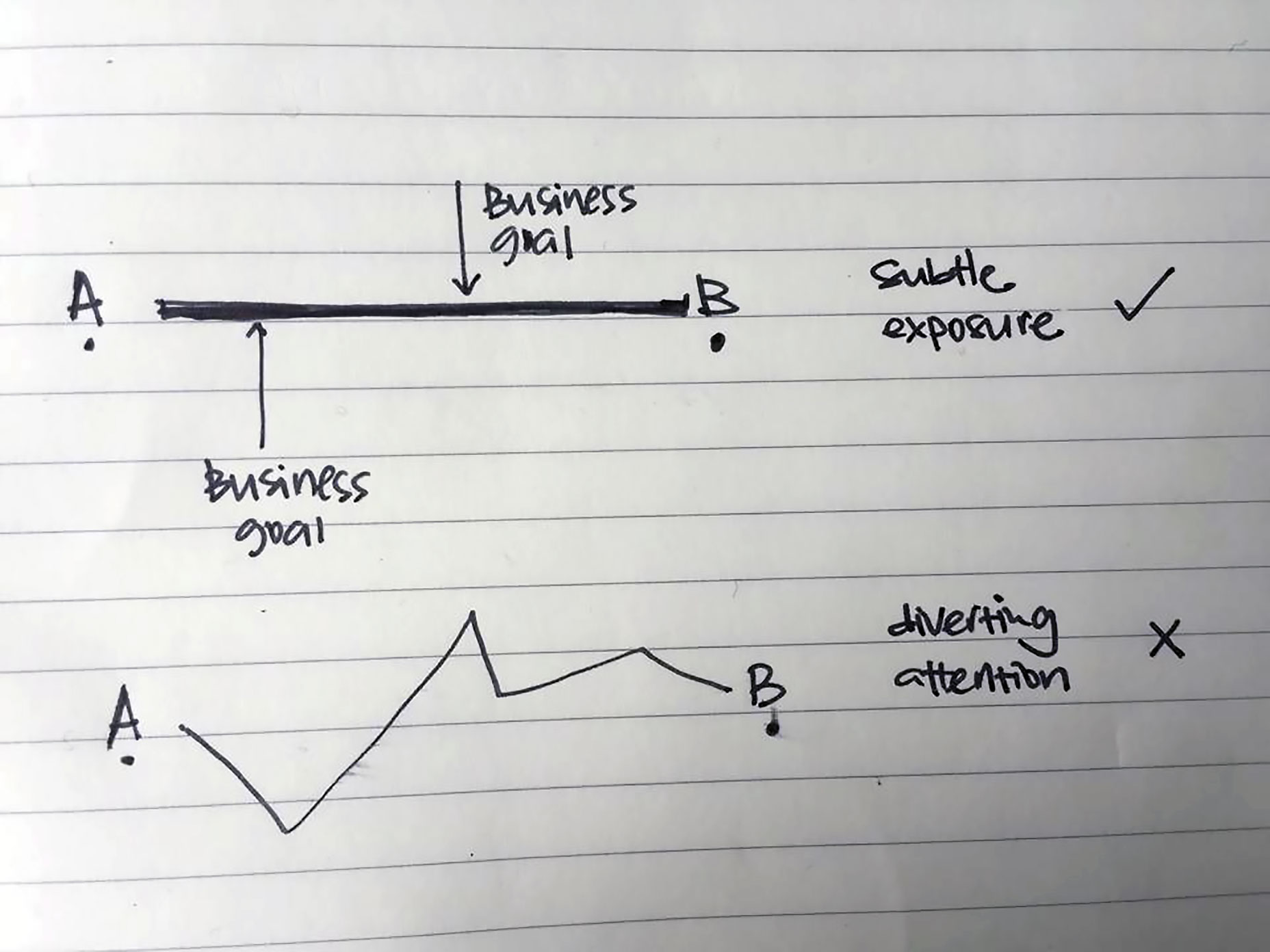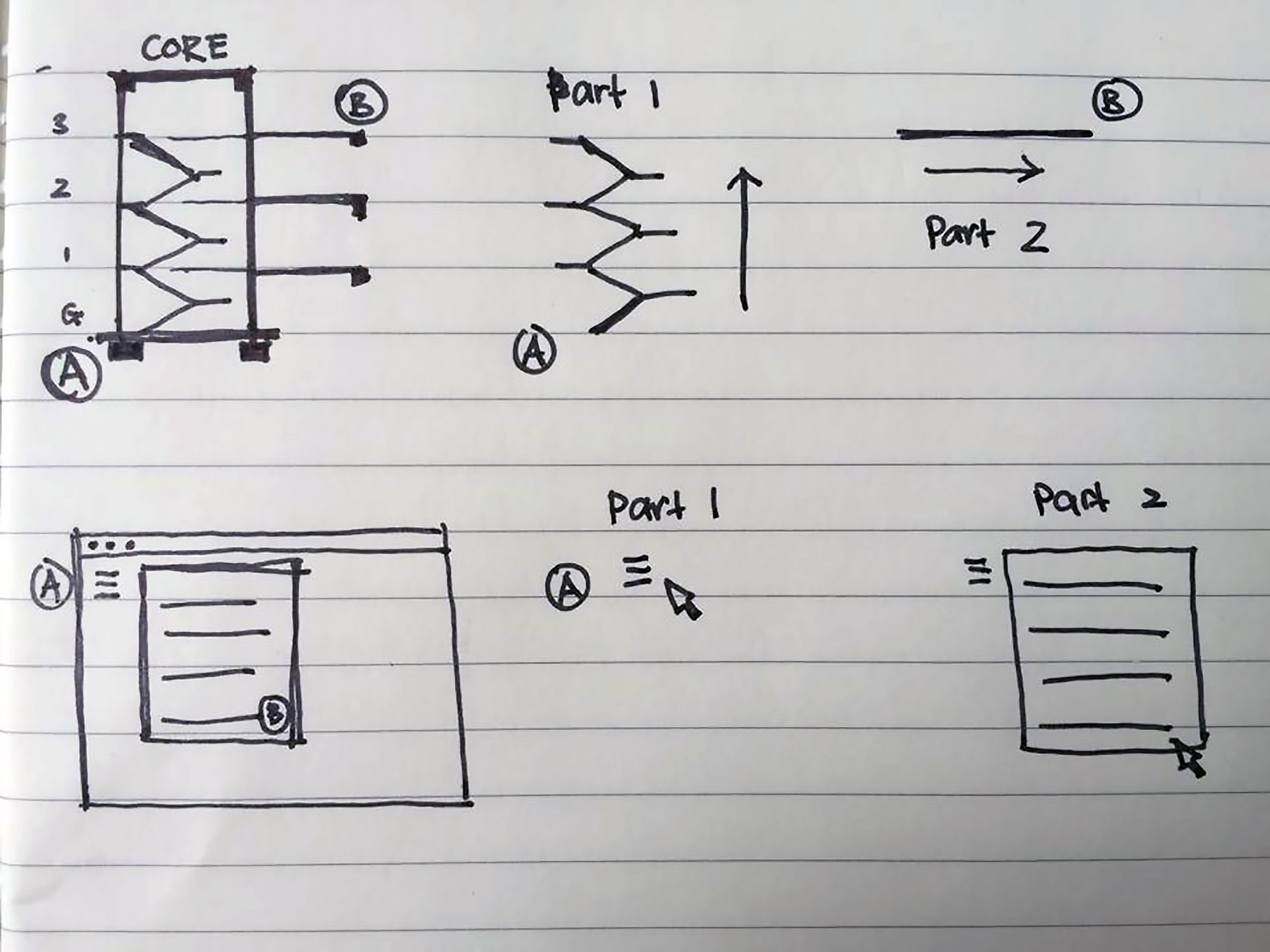
 Instead of diverting users away from their journey to fulfill these business goals, architects often practice deliberate and subtle exposure, injecting bits of it along the way. This could be done in the form of opening up corridors to give glimpses of another route, clever placement of signage, etc. In UX design, there are also elements to be considered which are part of meeting business goals. They could be goals for new user sign-ups, advertisements and product placements for increased monetization, etc.
Cues can be taken from common architectural design practices by introducing these elements only at appropriate and opportune moments during a user’s journey, and by keeping them visually cohesive with the rest of the site.
Instead of diverting users away from their journey to fulfill these business goals, architects often practice deliberate and subtle exposure, injecting bits of it along the way. This could be done in the form of opening up corridors to give glimpses of another route, clever placement of signage, etc. In UX design, there are also elements to be considered which are part of meeting business goals. They could be goals for new user sign-ups, advertisements and product placements for increased monetization, etc.
Cues can be taken from common architectural design practices by introducing these elements only at appropriate and opportune moments during a user’s journey, and by keeping them visually cohesive with the rest of the site.
Ease of navigation
A smooth journey contributes greatly to a pleasant experience for the user. Designing for seamless connectivity in architecture is very similar to designing for ease of navigation in UX design. Can you recall the last time you were in a building trying to get to any floor beyond the second floor, and there was no elevator? Maybe you felt annoyed, or maybe you might have even made a vow to never step foot in that building again! In architecture, the part where the elevators and staircases run is called the core. It is the main core of a building because it is essentially how people move between different spaces. The secondary circulation system is the horizontal path which one has to walk on to get to point B. Make it too long and winding, and you will end up with a frustrated user. [pullquote]if a user cannot find something on a page because of ineffective design, it is simply not there[/pullquote] Without an effective system for circulation both, vertically and horizontally, occupants are unable to access parts of that building. In addition, without proper signage, they might not even know these spaces exist. When that happens, those parts of the building can be deemed void. Building a strong core (circulation system) for a building is key for success. Just like in architecture, if a user cannot find something on a page because of ineffective design, it is simply not there. If the elevators and staircases in architecture make up its core; in UX, menus and tabs make up the main navigation system. If it is a frequently visited area of the building, it might make sense to make the journey shorter by placing it nearer to the core. Similarly, in UX design, reducing the number of clicks to get to a popular page improves the user experience. Introducing tabs on the landing page for the main pages of the site is one way to achieve that. In that way, the user does not have to open a menu to search for a page, thereby simplifying navigation.
If it is a frequently visited area of the building, it might make sense to make the journey shorter by placing it nearer to the core. Similarly, in UX design, reducing the number of clicks to get to a popular page improves the user experience. Introducing tabs on the landing page for the main pages of the site is one way to achieve that. In that way, the user does not have to open a menu to search for a page, thereby simplifying navigation.
Conclusion
In both architecture and UX design, the designer has to fulfill both the users’ goals as well as the business goals. When learning from architectural processes, one of the main things to note is that architects do not have the luxury to tear down their design once it is under construction. UX professionals are often spoiled so much in the sense that there is this notion that designs can be easily reiterated after gathering user feedback and data. This may be true in some cases but it often requires more time and work than expected. Creating a good foundation early on when planning for a product is good practice, and can reduce a lot of back-and-forth in its growth. A good architect is skilled in balancing the creation of delightful and smooth experiences in a building, and accomplishing his client’s objectives in the same experience. Applying architectural design thinking in this aspect will help you approach the design of your company’s product more effectively as a UX designer. Featured image, app architecture image via Shutterstock.Ling Lim
Ling Lim was an architectural designer in Singapore before she decided to pack her bags to explore her possibilities halfway across the world. She is now Head of Product Design at a growing startup, myWebRoom, based in San Francisco. When she is not solving problems, she enjoys powerlifting and visiting new places.
Read Next
15 Best New Fonts, July 2024
Welcome to our monthly roundup of the best fonts we’ve found online in the last four weeks. This month, there are fewer…
By Ben Moss
20 Best New Websites, July 2024
Welcome to July’s round up of websites to inspire you. This month’s collection ranges from the most stripped-back…
Top 7 WordPress Plugins for 2024: Enhance Your Site's Performance
WordPress is a hands-down favorite of website designers and developers. Renowned for its flexibility and ease of use,…
By WDD Staff
Exciting New Tools for Designers, July 2024
Welcome to this July’s collection of tools, gathered from around the web over the past month. We hope you’ll find…
3 Essential Design Trends, July 2024
Add some summer sizzle to your design projects with trendy website elements. Learn what's trending and how to use these…
15 Best New Fonts, June 2024
Welcome to our roundup of the best new fonts we’ve found online in the last month. This month, there are notably fewer…
By Ben Moss
20 Best New Websites, June 2024
Arranging content in an easily accessible way is the backbone of any user-friendly website. A good website will present…
Exciting New Tools for Designers, June 2024
In this month’s roundup of the best tools for web designers and developers, we’ll explore a range of new and noteworthy…
3 Essential Design Trends, June 2024
Summer is off to a fun start with some highly dramatic website design trends showing up in projects. Let's dive in!
15 Best New Fonts, May 2024
In this month’s edition, there are lots of historically-inspired typefaces, more of the growing trend for French…
By Ben Moss
How to Reduce The Carbon Footprint of Your Website
On average, a web page produces 4.61 grams of CO2 for every page view; for whole sites, that amounts to hundreds of KG…
By Simon Sterne
20 Best New Websites, May 2024
Welcome to May’s compilation of the best sites on the web. This month we’re focused on color for younger humans,…














